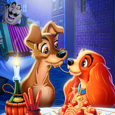DisneyToon Studios/Walt Disney Home Entertainment (February 27 2001), single disc, 70 mins plus supplements, 1.66:1 anamorphic widescreen, Dolby Digital 5.1 and DTS Surround, Rated G, Retail: $29.99
Storyboard:
Set right after the events from the 1955 classic, Scamp’s Adventure picks up as Lady and Tramp’s puppies are still growing up and finding their place. Scamp, like his father before him, yearns for adventure and the fun life. Tramp himself seems settled with Lady and their three girl pups and tries to instil in Scamp a sense of family and responsibility. When Scamp pushes things once too far with the dogs’ owner Mr Darling, he is tied to a post in the yard until he can calm down. Breaking his leash and seeing the chance for “freedom”, Scamp runs off into town, coming across the Junkyard Dogs – a bunch of strays who live the easy life – and meeting Angel, who secretly dreams of a life she’s never known: as a pet with a loving family. Soon Scamp is forced to decide between the wild life and the home life when the stray dogs’ leader Buster moves in on Angel, and leads Scamp into trouble a little too close to home…

The Sweatbox Review:
I admit it: against my better judgement, I’ve been pretty lenient on the direct-to-video and now theatrical sequels that the Disney Company has been churning out, mainly from their television division. By this, I don’t mean the obviously made for the Disney Channel quickies such as the “Aladdin Trilogy” sequels, or the lame attempt at continuing the Little Mermaid story (with all those helpful fade-outs ready for commercial placing!), but rather the newer films and theatrical releases. While still not up to the original’s classic standards, both Jungle Book 2 and 101 Dalmatians II: Patch’s London Adventure were rudimentary but brisk and light features, with Patch at least developing the characters a little more. Regular readers may also remember that Return To Never-Land, the first sequel I actually sat down and watched (I’m not counting The Rescuers Down Under among these spin-offs, as it was an official Feature Animation film), hit some kind of positive nerve in me, and I still uphold my feeling that it is the most recent traditionally animated film since perhaps Mulan or Tarzan to come from the Disney stable which honors the classic storytelling techniques of Walt himself.
Possibly a little too higher praise for some, but I found Never-Land a colorful showcase for the Australian Disney animation department, and it showed what they were capable of. Having not been at all interested in these sequel films up until this point (the sequences I did see at the time of Mermaid II and the Pocahontas follow up were enough to put me off for life!), the continuation of the Lady And The Tramp story originally completely passed me by. Now, with a new outlook on these films, and the temptation of revisiting some beloved characters, I’ve decided to take the chance to look back on the film for this review. I went in with an open mind…and came out very impressed indeed!
As with the other continuations of the Disney classics, in practically every one of these DTV movies, there are elements that get re-played from the original films in an attempt to link the two endeavors together. These films usually break down into two camps: the “mid-quel” attempt at filling in “gaps” from the original movie, or otherwise it’s the very mundane “child of the original protagonist re-steps their parents’ adventure”. Here, the romance between Scamp and Angel is the Lady/Tramp relationship all over again, but for some reason, this film’s re-hashing of such scenes does not feel like a rip-off. There is a sense of the familiar, but the scenes are staged from slightly different perspectives allowing even fans of the original to re-live a favorite moment with more of a sense of déjà vu than the feeling of watching a carbon copy. For instance, the inevitable spaghetti scene plays as a very sweet “reminder” moment and I for one didn’t roll my eyes at this point.

Walt himself, famously, was opposed to the very idea of sequels to his animated films. “You can’t top pigs with pigs!” he is said to have commented at the idea of more Three Little Pigs cartoons, but he eventually gave in, producing The Big Bad Wolf, Three Little Wolves and The Practical Pig. He also allowed additional films to many of his live-action hits, with Son Of Flubber following The Absent Minded Professor and a string of Merlin Jones/Medfield College mis-adventures. Lady And The Tramp itself was followed by a number of additional stories printed in comic book form, and it is these tales that closest inspire Scamp’s Adventure.
Many have been quick to jump up against these new films, myself included. Not all have succeeded, obviously, with most of the DTV titles deserving of their routes to the bargain bins and eventual television-trapped futures. However, as with Return To Never-Land and here with Scamp’s Adventure, every now and then one escapes from the bag and goes some way to proving that Disney still has the magic touch. Yes, these are not original stories, and it would be very interesting to see what this crew could come up with given a new idea, but when it comes down to it, the best place to see the kind of Disney features we remember from our childhood and throughout the renaissance of the 1990s, is right here on video. It may not be the thing many of us want to hear (and to be fair a batting average of two or three out of however many sequels there have been is not a great ratio), but Scamp’s Adventure really does deliver that old musical magic.

Despite not being shot in the CinemaScope widescreen ratio of the first film (it would have been nice for consistency, though it is correctly framed for 16×9), Scamp’s production design is very much in keeping with the original. The backgrounds especially evoke that turn of the century atmosphere, and the animation on the whole is a very close match to the style used in the 1950s at Disney’s. Characters are rounded, lip-sync is good and movement is smooth. We’re not restricted (as with most of these sequel films) to simply a repeat showing of the original cast either, with several new characters making their debuts. The filmmakers should be praised for this, for how easy would it have been to just re-use Peg and the rest of the down and out dogs for the sake of simplicity? Here, they take the bold step of not re-introducing any of the characters that they do not need to, and considerably expanding on existing ones (Scamp’s three sisters, for example, each have defining personalities).
Best of all is the dogcatcher, whom one would absolutely swear is a grand return to Disney voice work by Don Knotts. Resembling the actor both vocally and in appearance, the dogcatcher is actually voiced by regular Disney voice artist Jeff Bennett, who also helps Tramp to sound the same as he did 45 years before. Joining Bennett in the voice cast is a pretty decent selection of voice talent. He also provides Jock and Trusty’s not-a-pitch-different-than-the-original’s vocal tones, while Jodie Benson is instantly recognisable as Lady. The almost appropriately named Scott Wolf voices Scamp, and he comes across exactly as one might imagine from the original Disney comics. Roger (Hercules) Bart sings for the young pup, and the music score is perhaps the best, and certainly most “traditional”, in the growing DTV canon (Scamp’s A World Without Fences is as classic a Disney “I want” number as any, coming across with just the right amount of frustration and triumph). Scamp’s love interest, Angel, is played here by Alyssa Milano (yes boys, THAT Alyssa Milano). She’s how one might imagine Peg to be when she was a young pup, and is not content to just hang with the ruff dogs in town, knowing that she needs something more.
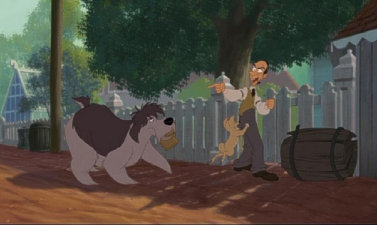
Whereas Lady needed the protection of Tramp in the outside world, here things are played differently. Not simply a reversal of roles like many of the sequels are content to provide, here the two dogs are on equal footing and must work together as a team to outwit their various opponents and survive. The story offers much to entertain, though those vehemently against these films will also find much to pick it to pieces with: the return to Tony’s restaurant for more spaghetti, the climatic chase sequence, etc. I found it to be a nice updating of the story that obviously plays a little more to the kids of today than the 1955 original did – something that, to be honest, I always found a little drawn out. Nice nods back to the first film also pop up in the backgrounds, such as the sidewalk where Lady and Tramp left their paw-prints, and one great touch has the scrap heap-dwelling villain living in the old cart that held Tramp captive and featured so predominantly in the final chase sequence in the original.
When it comes to the animation, I have found that there is a three-tier system running between Disney’s animation units. Obviously there are the “classic” features, created in rich and deep full animation and employing all the tricks of the trade at their disposal. At the other end of the spectrum is the TV division, which produce the animated series as well as many of these DTV movies. Most of these films are actually intended for TV broadcast eventually and are animated in the “Saturday morning” style, with cost-cutting techniques and a rushed approach to the visuals (the Aladdin, Cinderella, Pocahontas and Mermaid sequels especially follow this heavy “black marker” outline look). Falling somewhere in the middle is the stuff coming from, at first, the Canadian studio, and now the Australian crew – product that, while just not quite reaching the dizzying heights of the full Feature output, makes a good stab at maintaining those quality levels.
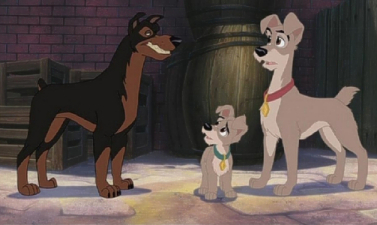
So far this crew have given us the Lion King, Peter Pan and Scamp films – titles that, oddly enough, rank among the best that this sub-genre has had to offer. Character lines are individually colored, more time is spent setting up situations and pay-offs, and the stories do try to be a little more than just the kids-in-same-peril-as-the-parents-once-were variety. By now, you’ll have an inkling that I warmed to Lady And The Tramp II: Scamp’s Adventure. It may not be the top dog that Walt’s original canine-led films once were, but is most certainly not the runt of the litter either!
Is This Thing Loaded?
Scamp’s Adventure falls amongst some of the earliest of Disney DTV releases, but somehow escapes the bare-bones approach to DVD. Perhaps as a result of their best-selling two disc editions, and also a desire to draw in the avid fan as well as the casual collector, Scamp comes to disc with a nice array of bonus features. Start up the disc, and we’re treated to the usual amount of promos and trailers for various other Disney product (the video releases of Snow White, the live-action 102 Dalmatians, The Emperor’s New Groove, The Book Of Pooh, Hunchback II and a Cinderella II teaser which uses footage from the original), all accessible again from the Sneak Peek menu.

The extras start proper with a nice surprise: a full-length audio commentary from the three principals in charge of directing: Darrell Rooney, co-director and producer Jeannine Roussel and animation supervisor Steve Trenbirth. The three are amiable enough, and go to great pains to explain that they were trying to compliment the original film and not replace it, but overall this is a good commentary track and worth listening to, as it’s the only one that I know of that has been included on a DTV title. These three speak with just authority and know of what they speak, and fair play to the Studio for allowing the important people on the production to have a voice as opposed to the sound bites from “executives in charge of being an executive” that we’ve had on some of the other DTV features. The three go into detail on both the creative and technical sides if things, highlighting how technology was able to help them replicate the lush, deep look of the original film on a fraction of the budget of a major feature – full marks for a great addition.
The more generic, but no less packed Making Of Lady And The Tramp II: From Tramp To Scamp features archival footage from both the original 1950s production and this new film. Much of the older material shown here is what would appear on the Platinum Edition of the original film, but the new stuff highlights again the advances in production technology and how the computer has enhanced the process (though a little more on the outstanding mimicking voice cast would have been appreciated). It’s mainly talking heads (including Walt himself, explaining the origins of the 1955 film), but is entertaining enough, also offering up some examples of continuity between the two films, and at 16-and-a-half minutes is a fairly in-depth and welcome glance behind the scenes.
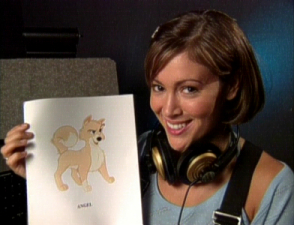
Tramp’s Hide And Seek Game (shouldn’t it be Scamp’s game?) is for the little ones, being a simple set-top adventure to find the canine stars of the main feature. Each dog the player finds fills up one of three kennels – fill up the kennels and be treated to a classic Disney cartoon. The game uses some new animation (or at least, re-cycled from the feature) and is a harmless way to pass the time, but don’t worry if you don’t feel like playing through to reach the shorts – they’re all selectable from the extras menu anyway! Featuring Pluto, the three cartoon shorts included here are 1940’s classic Bone Trouble, Pluto Junior from 1942, and Pluto’s Kid Brother from 1946. While these cartoons have been variously shown during the years in compilation shows and at least one featured on other DVD releases, they are a decent selection, though perhaps Pluto’s further adventures with junior versions of himself might have been a better choice than the often seen Bone Trouble. Certainly, the newer restored versions of the Pluto cartoons are worth seeking out, as these prints, although remastered, do look their age. However, they all add up to another 23 minutes of material – and classic Disney is never a bad thing!
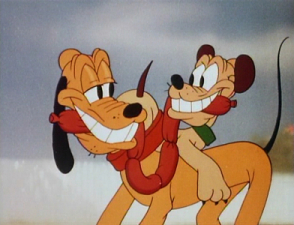
On the DVD-ROM side of things, a custom Scamp interface allows the playing of the movie and the set-top game again, as well as a DVD Destination Web Link to visit the online site. There’s some fun to be had there, with a tour of the town, production notes, screensavers, a color-in storybook and more to be found. As for “missing features” on the disc itself, a look at Scamp’s comic book history would have been a great addition to the extras overall, but what we are given provides a fine general look concerning this particular production.
Case Study:
Disney’s white keepcase keeps things safe, including a savings booklet, a catalog of DisneyDVD releases, and a double-sided insert listing the extensive 24 chapter indexes on one side and an overview of the bonuses on the other.
Ink And Paint:
Benefiting from a great digital-to-digital anamorphic transfer, Scamp looks every bit the pedigree the original was. Image registration is clean throughout, with the rounded colors of the production design coming through nice and warm. Character lines are not the strong, black, bold look of many of these direct-to-video features, instead having been individually colored in the style of the original. Those lines are well defined here, and color remains within them, as it should. There’s not a lot to complain about with this transfer at all – the correct 1.66:1 aspect ratio is preserved and presented as well as any recent animated feature would be – very nice.

Scratch Tracks:
Perhaps as an added incentive to buying these DTV films, Disney routinely offers DTS tracks as part of the package. Scamp is no exception, although as usual, I only found that the DTS had only a slight edge over the Dolby 5.1 mix, and not by a significant amount. Music seems to seep into the surrounds a little more in DTS, and there is a little more push in the bass, but pump up your Dolby woofer and the same effect is achieved. Dialogue in both mixes is locked center as expected, while effects and the rousing music play out over the left and right stereo pairs. This is a good mix, easily up there at the usual Disney feature film quality level, and really does help lift the film into a better placing, production-value wise. English subtitles and French and Spanish language Dolby 2.0 tracks are also included.
Final Cut:
Scamp’s Adventure really does give the often overlooked people at Disney’s Australian studio the chance to shine, from the standard contract voice-players to folks such as Danny Troob, a long-time associate of Alan Menken and arranger/orchestrator of many a Disney score, who provides and conducts the music here. Others who have their moment in the spotlight are directors Darrell Rooney and Steve Trenbirth, who show that they could both go the way of Kevin Lima and end up directing bigger budget features of their own. Making return trips to Disney are voice actors Jodie Benson (Lady) and Mickey Rooney (Sparky), while Melissa Manchester (The Great Mouse Detective) and Norman Gimbel (probably best known for the Wonder Woman TV theme!) keep the song quality up, with additional singing work by Susan Egan (Hercules’ Meg).
Running a brisk sixty-nine or so minutes (one shorter than the advertised 70 on the box, including a six-minute credit scroll), the film could have done with some slowing the pace on certain scenes and letting them breathe a little. It’s a shame that this feature was not selected to go the theatrical route (I believe that was first released before anyone thought that such a move was viable) as, even though it is fairly short, it’s a case of quality over quantity and never outstays its welcome. On DVD it’s worth checking out before it disappears, especially if you’re a fan of the original or someone who can get over the whole “sequel-itus” thing. Scamp proves no Tramp, that’s for sure!
 | ||
 |









